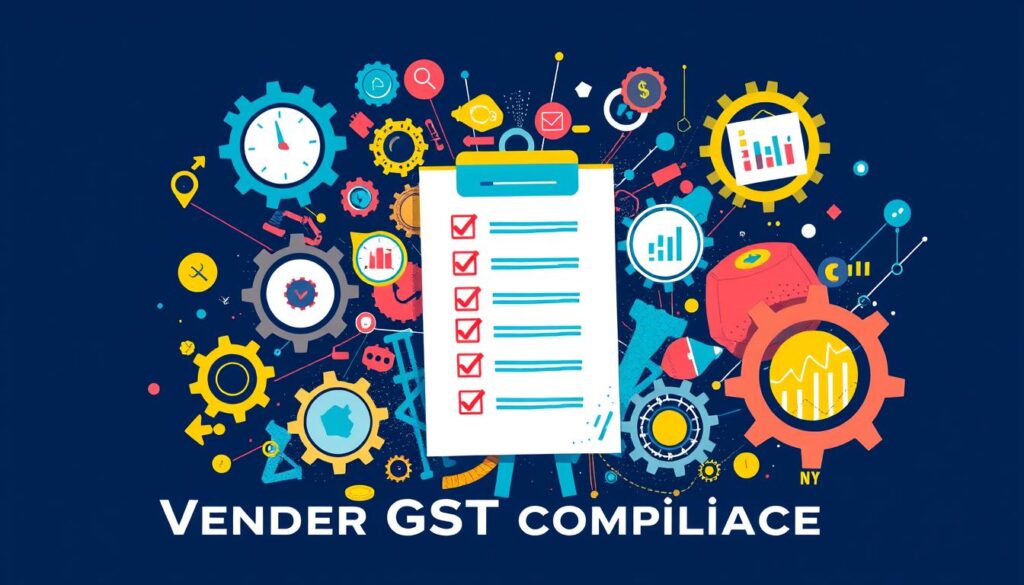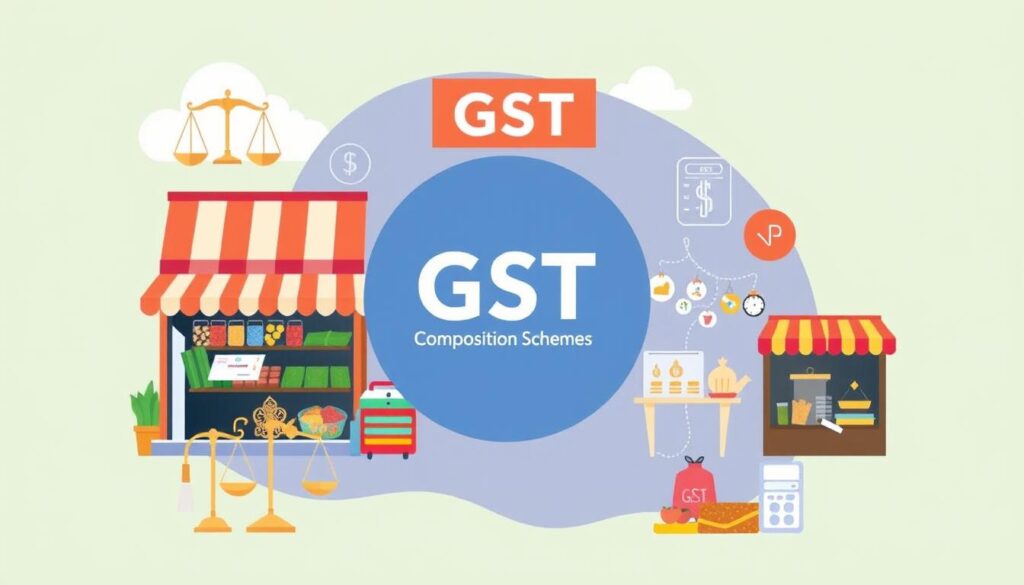Have you ever thought about if your vendors file their GST returns on time? Checking if your vendors comply with GST is key for your business. It helps keep your tax records accurate and ensures you get input tax credits. This guide will show you how to check GST return filed or not by vendor.
It’s important for your vendors to file their GST returns on time. If they don’t, it can affect your business’s taxes and credits. Keeping an eye on your vendors’ GST status helps you avoid audits and makes tax filing smoother.
Importance of Verifying Vendor GST Return Filing Status
Keeping up with vendor GST compliance is key for businesses. It ensures they can claim input tax credits and stay ready for audits. Knowing how to check GST return filed or not by vendor is vital. It helps avoid penalties and keeps businesses in line with GST rules.
Timely GST Return Filing by Vendors
Vendors must file Form GSTR-1 by the 11th of the next month if they file monthly. For quarterly filers, it’s the 13th of the month after the quarter. Quarterly filers need to file both GSTR-1 and GSTR-3B every quarter. It’s crucial to make sure vendors file on time to keep the input tax credit process smooth.
Input Tax Credit Eligibility
Businesses can only get input tax credit with valid invoices from vendors. If a vendor doesn’t file on time, the invoices won’t show up in the buyer’s GSTR-2A. This means no input tax credit. So, checking vendors’ return filing status regularly is a must. Understanding how to check GST return filed or not by vendor is crucial for maintaining compliance and maximizing available credits.
GST Compliance and Audit Readiness
Monitoring vendors’ GST return filing status keeps businesses compliant and ready for audits. On-time filing and accurate invoice reporting are crucial for passing GST audits. Checking vendors’ compliance ensures businesses can provide the needed documents and avoid penalties or legal trouble.

To verify vendor GST return filing status, check GSTR-1 and GSTR-3B on the GST portal. By keeping a close eye on vendor compliance, businesses can smoothly claim input tax credits. This also boosts their GST audit readiness.
Accessing the GST Portal
Getting into the GST portal is key for businesses in India. It’s vital for both new and existing users to know how to use it. This guide will help you get started with accessing, registering, logging in and understanding how to check GST return filed or not by vendor. It covers everything you need to get started and make the most of the GST portal’s features
Registering on the GST Portal
First, go to the official website at www.gst.gov.in. If you’re new, you’ll need to sign up. You’ll have to give your GSTIN, business info, and contact details. After signing up, you can make your login info, like a username and password.
Logging into the GST Portal
If you’re already registered, just log in with your username and password. Once logged in, you can do lots of things. This includes filing returns, searching for taxpayers, and checking your return status. The portal is easy to use, so finding what you need is simple.
The Returns Dashboard is a big part of the GST portal. It lets you manage your GST filings and see your return status. Here, you can file returns, check your vendors’ filing status, and see if you’re eligible for input tax credit.

It’s important to get to know the GST portal and its features. This ensures your business stays on top of GST rules. By understanding how to register and log in, you can make GST management easier and stay current.
Searching for Vendor GST Details
It’s important to check if your vendors have filed their GST returns on time. This helps keep your business in line with GST rules and lets you claim input tax credits. Knowing how to check GST return filed or not by vendor helps you stay aligned with regulatory requirements. You can find your vendors’ GST details by using the “Search Taxpayer” tool on the GST portal.
Using the Search Taxpayer Feature
To find a vendor’s GST details, follow these steps:
- Go to the GST portal (www.gst.gov.in).
- Click on “Search Taxpayer.”
- Choose to search by “GSTIN” or “UIN.”
- Put in the vendor’s 15-digit GSTIN or UIN.
- Enter the captcha code shown on the screen.
- Click “Search” to get the vendor’s GST details.
The search will show you the vendor’s GST registration status. You’ll see their legal name, business location, and more.
Searching by GSTIN or UIN
The GSTIN is a 15-digit number given to GST-registered businesses. It’s needed for invoices. You can also search by the vendor’s UIN, for government departments and embassies.
By doing a GST taxpayer search or GSTIN search, you can check if your vendor is GST-compliant. This ensures they meet their GST return filing duties.
| Feature | Description |
|---|---|
| GST Taxpayer Search | A feature on the GST portal that allows you to search for a vendor’s GST details using their GSTIN or UIN. |
| GSTIN Search | The process of searching for a vendor’s GST details using their 15-digit GSTIN. |
| UIN Search | The process of searching for a vendor’s GST details using their Unique Identification Number (UIN). |
Using the GST taxpayer search, GSTIN search, and UIN search on the GST portal helps. It makes sure your business partners follow GST rules. This avoids problems with input tax credits and GST audits.
Interpreting Vendor GST Return Filing Status
Keeping up with GST rules is key for businesses. It’s important to watch your vendors’ return filing status closely. This helps make sure your input tax credit claims are valid and your business is ready for audits.
Understanding GST Return Filing Frequency
GST returns can be filed monthly (GSTR-3B) or quarterly (GSTR-1), based on your annual sales. If your sales are under ₹1.5 crore, you can file quarterly. But, if your sales are higher, you must file monthly. Knowing your vendors’ filing schedules helps you stay on top of their compliance.
Identifying Filed and Pending Returns
The GST portal shows the status of GSTR-1 and GSTR-3B returns. Filed returns are marked as “Submitted,” and pending ones are highlighted. Make sure the filing dates match the due dates. Watching your vendors’ return status helps keep your business compliant and eligible for tax credits.
Checking your vendors’ GST return status regularly keeps you ahead of compliance issues. This proactive step not only protects your tax credits but also boosts your GST compliance.
Verifying Invoice Details in GSTR-2A
As a GST-registered business, it’s vital to keep an eye on your vendor’s GST return filing status. Make sure their invoices are right in your GSTR-2A. GSTR-2A is a purchase register that shows your business’s inward supplies from your vendors’ GSTR-1 returns.
Accessing GSTR-2A on the GST Portal
To get to GSTR-2A, log into the GST portal and go to the Returns Dashboard. Pick the right financial year and return filing period. The GSTR-2A section will show the auto-populated invoice details from your vendors’ GSTR-1 filings.
Matching Invoice Details with Vendor Returns
Check the invoice details in GSTR-2A against the physical invoices from your vendors. Make sure the GSTIN, invoice number, invoice date, taxable value, and tax amounts match. This step is key for claiming the right input tax credit (ITC).
Handling Missing or Mismatched Invoices
If you find missing or mismatched invoices in GSTR-2A, contact your vendors quickly. Work with them to fix the issues and get the right invoice details in their GSTR-1 filings. Regularly reconciling GSTR-2A with your vendor invoices is crucial for accurate ITC claims and avoiding penalties.
Remember, the GSTR-2A verification, invoice matching, and GST invoice reconciliation process is key for your GST compliance and financial reporting accuracy.
Consequences of Vendor Non-Compliance
When vendors don’t follow GST rules, it can hurt businesses that work with them. A big problem is the denial of input tax credit (ITC). If a vendor doesn’t file GST returns or report invoices right, the business can’t claim ITC. This means the business has to pay more taxes and might lose money.
Also, GST non-compliance by vendors can lead to penalties and legal issues. The CGST Act lists 21 GST offenses, from fake invoices to not following supply rules. The fines can be high, from Rs. 200 a day for late returns to 100% of tax due or Rs. 10,000 for not filing.
For fraud or tax evasion, the fines can be even higher. There could be jail time of up to 5 years. Also, a fine of up to Rs. 25,000 can be given for helping with GST fraud. If a business is not supposed to use the composition scheme but does, they could face a penalty of 100% of tax due or Rs. 10,000.
It’s very important for businesses to check if their vendors have filed their GST returns. Not doing this can cause big problems, like losing money, facing legal issues, and damaging their reputation.
Denial of Input Tax Credit
If a vendor doesn’t file their GST returns or report invoices right, the business can’t claim ITC. This means the business has to pay more taxes and might lose money.
Penalties and Legal Implications
Not following GST rules can lead to penalties and legal problems for both the vendor and the business. The fines can be from Rs. 200 a day for late returns to 100% of tax due or Rs. 10,000 for not filing. For fraud or tax evasion, the fines can be even higher, including jail time of up to 5 years.
“Every taxable person has the right to a show-cause notice before any penalty is imposed, allowing a chance for explanation and hearing.”
It’s very important for businesses to check if their vendors have filed their GST returns. Not doing this can cause big problems, like losing money, facing legal issues, and damaging their reputation.
How to check gst return filed or not by vendor
It’s important to make sure your vendors file their GST returns on time. This is key for staying compliant and getting input tax credits. Learning how to check GST return filed or not by vendor is straightforward and this GST return verification process is simple and helps you keep track of your vendor’s tax status.
Step-by-Step Guide to Verifying Vendor GST Return Filing
- Access the GST portal and log in to your account.
- Use the “Search Taxpayer” feature on the portal.
- Enter your vendor’s GSTIN to get their return filing details.
- Check the status of your vendor’s GSTR-1 and GSTR-3B returns to see if they’re filed on time.
- Look at the invoice details in your GSTR-2A return to make sure they match your vendor’s filings.
Documenting and Reporting Non-Compliant Vendors
If your vendor hasn’t filed their GST returns or there are issues with invoice details, document these problems. You should also report the non-compliance to the right authorities. Not filing GST returns can lead to losing input tax credits, financial penalties, and legal trouble for your business. By checking your vendor’s GST return filing status, you can avoid these risks and keep your supply chain compliant.
| GST Return Verification Process | Key Benefits |
|---|---|
| Checking vendor GSTIN and return filing status | Ensures eligibility for input tax credit claims |
| Reconciling invoice details in GSTR-2A | Identifies discrepancies and non-compliance issues |
| Documenting and reporting vendor non-compliance | Mitigates financial and legal risks for the business |
By regularly checking your vendor’s GST return filing status, you can keep your supply chain compliant. This also helps you optimize your input tax credit eligibility and improve your GST non-compliance reporting processes.
Conclusion
Checking the GST return filing status of vendors is key for tax compliance. It ensures businesses can claim input tax credits. By following this guide, companies can check vendor compliance, match invoices, and avoid risks from non-compliant vendors.
Keeping a close eye on vendor GST return filings is vital. It helps protect a business’s input tax credit claims. It also makes sure the business is ready for GST audits.
Using the best practices for checking vendor GST returns helps businesses file on time. It also helps them claim input tax credits correctly. This approach reduces financial risks and makes the tax system in India more transparent and efficient.










